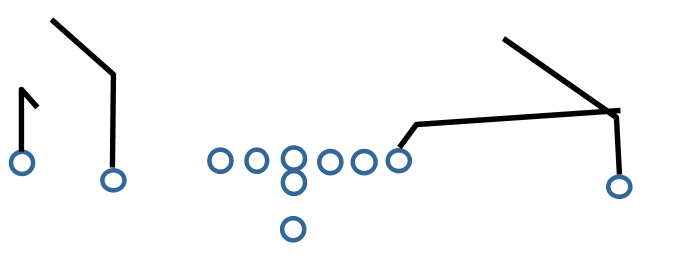Motivation
“Three things can happen when you put a ball in the air — and two of them are bad.”
— Duffy Daugherty
Well, I’d even say: “When you try to put the ball in the air, four things can happen, and three of them are bad”: of course the completion is the only good outcome, the others are a sack, an incompletion or an interception. The art of the passing coordinators is now to adjust everything so the chances are mostly in favor for a completion.
That means you have to minimize the chances for the three bad outcomes.
- The sack: the shorter the time the quarterback holds the ball before he throws it the smaller the chances for any defender to beat the passblocker and get to the quarterback to sack him.
- The incompletion: the shorter the ball is thrown the smaller is the margin of error (the more precise the pass is in general) and the less time the defenders have to get into the passing lane to deflect or intercept the pass.
- The interception: the easier the reading progression for the quarterback the better. The chance to make the false decision rises with the complexity of the decision-process (the reading-progression).
Blocking for the 3 step passing game
Since the quarterback will not hold the ball for a long time, the pass-blockers don’t need to protect the Quarterback for an extensive time, but they should be able to make sure he definitly has at least the time he needs, without even worring about the pass-rush.
Since the blockers don’t need to hold their blocks for long they can be more aggressive. The offensive linemen shouldn’t give to much ground so the quarterback can see enough and since the quarterback himself takes just three steps back they cannot give much ground without stepping literally onto his toes.
The blocking scheme is a simple B-O-B (big on big and backs on backers).
- The covered lineman will block the defender who lines up on them:
- The first step is a short lead step (with the foot towards which side he has to step – therefore rather wideing the stance than narrowing it) forward to position the blocker exactly between the defender and the set-point of the quarterback (which is by nature more or less on the inside number of the defender). During that step the Blocker cocks his arms (brings his hand back to his armpits, elbows back and tight to the body, thumbs up and fingers out).
- The second step is a pickup step to ajust the feet position to a good balanced stance while the hands fire out into the defenders chest (but without leaning into the defender). This should slow the defender down almost enough for the quarterback to deliver his pass.
- After that the blocker should step back with his outside foot just enough to get into a slightly staggered stance, keep his shoulders square and doesn’t allow any penetration.
- The uncovered linemen will take a small step back with their outside foot to get into a slightly staggered stance being prepared to block any defender who tries to cross the line-of-scrimmage in his area (the gaps left and right from him).
- The blocking back(s) should look for blitzing linebackers or defensive backs. And try to block them as close to the line-of-scrimmage as possible.
The Quarterback’s dropback
As it is already called the 3-Step passing game, the quarterback takes a 3-step dropback:
- The first step is with the foot of his throwing arm and is a big step – almost a jump – with a good hard pushoff from the other foot.
- The second step is a shorter crossover step, already slowing down the dropback again.
- The third step is already the plant step. This has to be so balanced that the quarterback would be able to directly take a throwing step in whatever direction he wants. – The most common mistake is to take a too big plant step, since the Quarterback gets stuck in te position for too long and he can’t throw right off the plant step and he stands not tall enough so it’s harder than nessesary for him to see and throw over onrushing defenders.
The Receiver’s stance and release
Since a good timing between quarterbach and receiver is crucial in the 3-step passing game a good constant release by the wide receiver is very important.
A good release begins with a good stance:
The stance
- The inside foot is always the front foot, toes turned inward, knee over toes.
- The heel of the back foot is on the ground, the leg almost straight.
- The upper body leans slightly forward building approximatly a straight line with the back leg.
- The hands are loose fists touching at the knuckles, at about the same height as the elbows.
- The head is up, looking at the defender in front of him – or if crowd-noise demands looking in onto the ball.
The release
- All routes but one begin with at least three steps forward at full speed with arms pumping.
- The receiver always has to sell the defender that he is going deep.
The Widereceiver Routes
There are just a few simple routes that are used with the 3-step passing game, since there is actually no time for more fancy routes.
These are the base rules – there are some variations due to coverage and actual play.
- The Hitch
- Three steps straight at fullspeed, two breakng steps (sinking the hips!) turn to the inside – ball should almost be there.
- The Speedout
- This is the only route without three straight steps. One step forward, then already turn to the outside – no need for a sharp cut – never getting deeper than 5-6 yards, rather coming slightly back towards the line of scrimmage than drifting deeper.
- The Slant
- Three steps straight at fullspeed, plant outside foot and accelerate through the cut at approximately 45° angle (but never directly towards a near defender)
- The Out
- Four steps straight at fullspeed, plant inside foot and cut at an 90° angle to the outside, rather coming slightly back towards the line of scrimmage than drifting deeper.
- The Quick Corner
- Four steps straight at fullspeed, plant inside foot and accelerate through the cut at an 45° angle to the outside bending it up the field never getting closer than 4 yards to the sideline unless the ball is thrown there.
- The Fade/Fly
- This route goes just straight up the field, the receiver should try to pass his defender on the out side unless he clearly gives him the inside.
- The Choice
- This route is actually defined by the defense and therefore is much more errorprone than the others and should only be implemented at an advanced level of play!
Against zone the defender runs a Hitch, expecting the ball on the shoulder away from the nearest defender – if the ball is not thrown he tries to stay between the defenders “splitting the zones”.
Against man coverage run the Out.
The Runningback Routes
Routes out of the backfield are run similar but first from the starting position towards the line of scrimmage about 1yard outside the tackle position.
- The Speedout will be run from that point towards 5 yards deep at the sideline.
- The Slant will be run directly from that point at approximately 45° to the inside.
- The Choice actually gets an additional variation: The Check-Through: On this route the Runningback runs straight forward between the Offensive Linemen gets to a depth of about 6 yards and sits beween the zones, on man coverage he just runs away from the covering defender (parallel to the line of scrimmage).
- The Swing is a runningback only route. The runningback runs paralell to the Line of Scrimmage – looking immediatly over his inside/upfield shoulder – until he reaches the numbers. From there he turns in an arc upfield. The quarterback should have thrown the ball by then anyway – if not the scramble rules apply.
- The Check-Swing is a variation of the Swing in that the RB takes one step forward with his inside foot (the foot away from the side he should run the swing). If he lines up behind the QB his step should go in an 45°-angle to the “swing”-side. If a defender on that side reaches the Line-Of-Scrimmage unblocked/unchallenged within the time the RB takes that one step, the runningback attacks him and blocks him as close to the LOS as possible, otherwise the runningback runs his swing route.
The Tightend Routes
The tightend routes are just the same as the Wide-receiver routes with the following variations:
He always takes the easiest release, avoiding as much contact as possible, if he get’s delayed due to intense contact he shortens his route.
The Presnap Read
Sinde the quarterback has very limited time to scan the field during his dropback he has to make already some decisions before the snap of the ball.
- He scans the field before the snap and tries to determine the possible coverage by the defense
- Then he decides depending on the called routes and employed personnel which side he wants to attack.
- Then he identifies the defender he has to read.
The Dropback Read
So, depending on the route-combination to the chosen side he has exactly one defender (mostly the cornerback) to read. This defender has just a limited number of reasonal actions. And for each route-combination – action pair the quarterback has a clear and precise rule who to throw the ball to.

